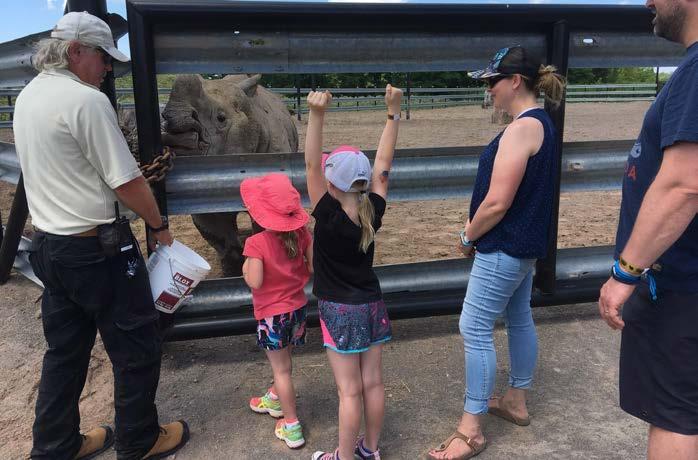
5 minute read
Behind the Scenes at Safari Niagara
by andrew hind


Safari Niagara is a privately-owned and operated accredited nature park that is home to more than 1000 species of wildlife, many of them endangered in their native habitat. The park, which supports multiple conservation efforts, was founded with the vision of providing visitors with the opportunity to meet animals up close. The hope is that such interactions will inspire visitors to share Safari Niagara’s goal of conserving biodiversity.
Important to realizing this ambition is Safari Niagara’s behind-the-scenes tours, which offer patrons a more intimate experience with the animals. Each of the four distinct, 45-minute tours highlights one specific species: giraffes, lions, rhinos, and bears.
“Our behind-the-scenes tours help people make personal connections with our animals and inspire a love for wildlife. We do our best to encourage actions that will help protect and conserve our natural world,” explains Safari Niagara’s general manager, Taryn Hipkiss. “We have a lot of guests with specific questions who are seeking one on one time with our zookeepers.”
“A percentage of proceeds from our behind-the-scenes tours is donated,” Hipkiss adds. “Through proceeds raised for the International Rhino Foundation, Safari Niagara sent 20 investigative kits to help India’s forest guards investigate wildlife crimes and secure evidence for convictions against poachers.”
Conservation goals aside, these tours are just plain fun. The giraffe tour is arguably the most popular of the four. Safari Niagara’s giraffes are an endangered subspecies native to the Horn of Africa known as the reticulated giraffe. “Accredited zoos work together to maintain healthy, sustainable populations under expert care. Giraffes, as a whole, are ,classified as Vulnerable by the IUCN Red List and their numbers are decreasing,” explains Breah Sovegjarto, Safari Niagara’s educational programs developer. In the case of the reticulated giraffe there are approximately 16,000 remaining in the wild.
Part of maintaining a sustainable captive population is ensuring animals have a healthy environment in which to live. Accredited facilities work hard to ensure the animals in their care are afforded the proper space, nutrition, and choice.
“Tour participants have the opportunity to feed our giraffes, which people always love,” says Sovegjarto. “In the wild, giraffes will typically eat acacia tree leaves and branches. During the Behind the Scenes tour, participants can feed specially formulated grains and fresh produce like lettuce.”
Like giraffes, African lions are threatened in the wild. During the Behind the Scenes lion tour, keepers will discuss the plight of these majestic felines and the importance of maintaining a sustainable ex-situ population. Moreover, participants will learn intimate details about the social dynamics of the Safari Niagara pride.
“Rather than a feeding experience, says Sovegjarto, “we set out an enrichment for our lions so we can watch them emulate natural foraging and hunting techniques. It’s an amazing experience to see up close.”
Safari Niagara boasts two species of rhino, White and Indian. Rhinos are powerful giants. Participants in the rhino tour can stand next to one of these massive creatures, putting their size and strength into perspective. White rhinos, the larger of the two species, can stand almost 6’ at the shoulder, measure up to 13 feet long, and weigh more than 7,000 lbs. The smaller Indian rhino species, although not as tall, is still a force.

A highlight is the opportunity to gently rub a rhino’s famously thick hide. “The skin of an Indian Rhino looks like armour, as many people think, but those deep folds in the skin are actually quite sensitive,” explains Sovegjarto. These folds play an important role. Indian Rhinos love to spend time in the water. Moisture is retained in these folds which helps to keep them cool.
Safari Niagara is home to 2 species of bears: the American black bear and the Syrian brown bear. In the case of the Syrian Brown Bear, habitat fragmentation has seen the species extirpated in Syria. Currently, scattered populations remain in Turkey and the Caucasus. The Syrian Brown Bear is larger than the American Black Bear that we are all familiar with, yet it is a smaller subspecies of Brown Bear.
The Animal Care team at Safari Niagara was excited to launch their Behind the Scenes Bears tour in 2023 and hopes that discussions about the current status of the Syrian Brown Bear population might encourage participants to think about human and wildlife coexistence. “Conflict with animals like bears, and this applies equally to other species such as the Eastern Massassauga Rattlesnake here in Ontario, are often the result of misunderstanding,” says Sovegjarto. “People might worry about coexisting with such wildlife, but we need to remember that these species are important to biodiversity. We need them.”
Sovegjarto stresses that an additional challenge arises when people want to get close to wild animals to pet them or get a great photo. This can put them and the animal at risk.
“Accredited facilities like Safari Niagara offer opportunities to get close without putting people or animals in danger,” she says. “That’s one of the appeals of our behind-the-scenes tours. The experience is intimate, educational, and safe for everyone – animal and human.”
Tickets for behind-the-scenes-tours costs $60 per person, reservations are required. For more information or to book a tour: visit safariniagara.com.
ENJOY NIAGARA HISTORY COMES ALIVE











